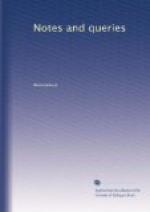7. This figure is derived from the Hebrew [Hebrew: z], zayin, which in the Estrangelo-Syriac is merely a 7 reversed.
8. This figure is merely a rounded form of the Samaritan Kheth (a travelling scrip, with a string tied round thus, [Character]). The Estrangelo-Syriac [Character] also much resembles it.
9. Identical with the Indian and Arabic.
0. Nothing; vacuity. It probably means the orb or boundary of the earth.—10. is the first boundary, [Hebrew: tchwm], Tekum, [Greek: Deka], Decem, “terminus.” Something more yet remains to be said, I think, on the names of the letters. Cf. “Table of Alphabets” in Gesenius, Lex., ed. Tregelles, and “NOTES AND QUERIES,” Vol. i., p. 434.
E. S. T.
Arabic Numerals.—With regard to the subject of Arabic numerals, and the instance at Castleacre (Vol. ii., pp. 27. 61.), I think I may safely say that no archaeologist of the present day would allow, after seeing the original, that it was of the date 1084, even if it were not so certain that these numerals were not in use at that time. I fear “the acumen of Dr. Murray” was wasted on the occasion referred to in Mr. Bloom’s work. It is a very far-fetched idea, that the visitor must cross himself to discover the meaning of the figures; not to mention the inconvenience, I might say impossibility, {340} of reading them after he had turned his back upon them,—the position required to bring them into the order 1084. It is also extremely improbable that so obscure a part of the building should be chosen for erecting the date of the foundation; nor is it likely that so important a record would be merely impressed on the plaister, liable to destruction at any time. Read in the most natural way, it makes 1480: but I much doubt its being a date at all. The upper figure resembles a Roman I; and this, with the O beneath, may have been a mason’s initials at some time when the plaister was renewed: for that the figures are at least sixty years later than the supposed date, Mr. Bloom confesses, the church not having been built until then.
X.P.M.
* * * * *
CAXTON’S PRINTING-OFFICE.
(Vol. ii., pp. 99. 122. 142. 187. 233.)
I confess, after having read MR. J.G. NICHOLS’ critique in a recent number of the “NOTES AND QUERIES,” relative to the locality of the first printing-press erected by Caxton in this country, I am not yet convinced that it was not within the Abbey of Westminster. From MR. NICHOLS’ own statements, I find that Caxton himself says his books were “imprynted” by him in the Abbey; to this, however, MR. NICHOLS replies by way of objection, “that Caxton does not say in the church of the Abbey.”




